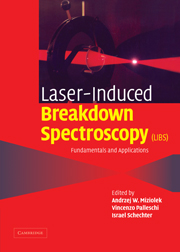Book contents
- Frontmatter
- Contents
- List of contributors
- Preface
- 1 History and fundamentals of LIBS
- 2 Plasma morphology
- 3 From sample to signal in laser-induced breakdown spectroscopy: a complex route to quantitative analysis
- 4 Laser-induced breakdown in gases: experiments and simulation
- 5 Analysis of aerosols by LIBS
- 6 Chemical imaging of surfaces using LIBS
- 7 Biomedical applications of LIBS
- 8 LIBS for the analysis of pharmaceutical materials
- 9 Cultural heritage applications of LIBS
- 10 Civilian and military environmental contamination studies using LIBS
- 11 Industrial applications of LIBS
- 12 Resonance-enhanced LIBS
- 13 Short-pulse LIBS: fundamentals and applications
- 14 High-speed, high-resolution LIBS using diode-pumped solid-state lasers
- 15 Laser-induced breakdown spectroscopy using sequential laser pulses
- 16 Micro LIBS technique
- 17 New spectral detectors for LIBS
- 18 Spark-induced breakdown spectroscopy: a description of an electrically generated LIBS-like process for elemental analysis of airborne particulates and solid samples
- Index
- References
8 - LIBS for the analysis of pharmaceutical materials
Published online by Cambridge University Press: 08 August 2009
- Frontmatter
- Contents
- List of contributors
- Preface
- 1 History and fundamentals of LIBS
- 2 Plasma morphology
- 3 From sample to signal in laser-induced breakdown spectroscopy: a complex route to quantitative analysis
- 4 Laser-induced breakdown in gases: experiments and simulation
- 5 Analysis of aerosols by LIBS
- 6 Chemical imaging of surfaces using LIBS
- 7 Biomedical applications of LIBS
- 8 LIBS for the analysis of pharmaceutical materials
- 9 Cultural heritage applications of LIBS
- 10 Civilian and military environmental contamination studies using LIBS
- 11 Industrial applications of LIBS
- 12 Resonance-enhanced LIBS
- 13 Short-pulse LIBS: fundamentals and applications
- 14 High-speed, high-resolution LIBS using diode-pumped solid-state lasers
- 15 Laser-induced breakdown spectroscopy using sequential laser pulses
- 16 Micro LIBS technique
- 17 New spectral detectors for LIBS
- 18 Spark-induced breakdown spectroscopy: a description of an electrically generated LIBS-like process for elemental analysis of airborne particulates and solid samples
- Index
- References
Summary
Introduction
The uniform distribution of pharmaceutical materials such as drugs, lubricants, and other components used in the formulation of pharmaceutical powder blends and tablet dosage forms is critical in order to achieve optimal product performance. Ideally, each of the several million tablets produced during the manufacture of a batch should contain the same amount of each component. In practice, however, this goal is difficult to achieve because the pharmaceutical solids that are blended together generally have wide particle-size distributions as well as dissimilar bulk properties, such as density, shape, specific surface area, and energy. The analytical technologies that are currently available for the determination of the components in these tablet dosage forms are time consuming, i.e. 10–30 min per sample, can be laborious, and are not readily amenable to at-line or on-line process monitoring. About 70% of the marketed drug products are formulated as tablet or capsule dosage forms where the drug molecules contain one or more chlorine, sulfur, fluorine, sodium, potassium, magnesium, phosphorus, or calcium elements as integral parts of their structure. Laser-induced breakdown spectroscopy (LIBS) was found to be a good analytical technique to measure quickly the surface and internal distribution of many pharmaceutical materials, i.e. drugs and excipients, used in the formulation of solid dosage forms. The determination of this distribution is valuable to pharmaceutical research and development since it leads to a better understanding of formulations and manufacturing processes as well as improvements in at-line process monitoring.
- Type
- Chapter
- Information
- Laser Induced Breakdown Spectroscopy , pp. 314 - 331Publisher: Cambridge University PressPrint publication year: 2006



